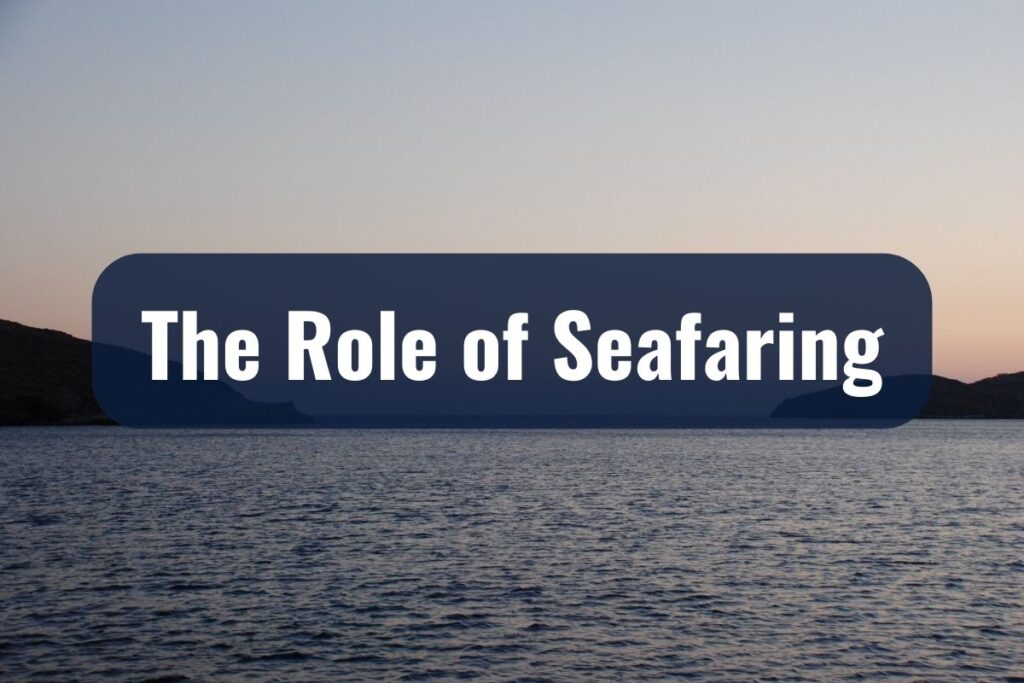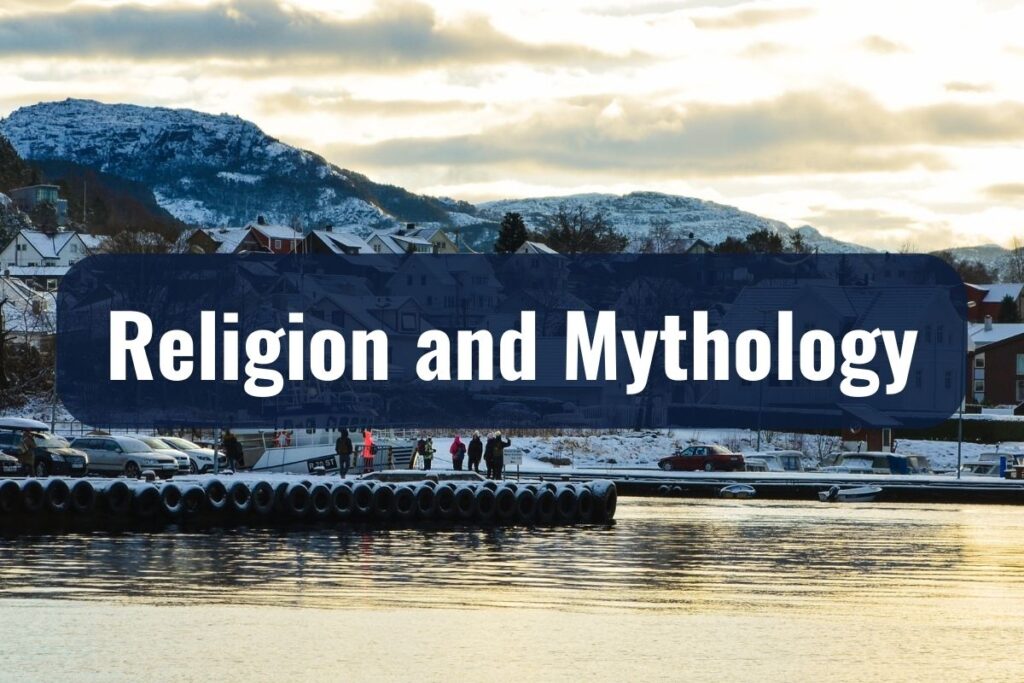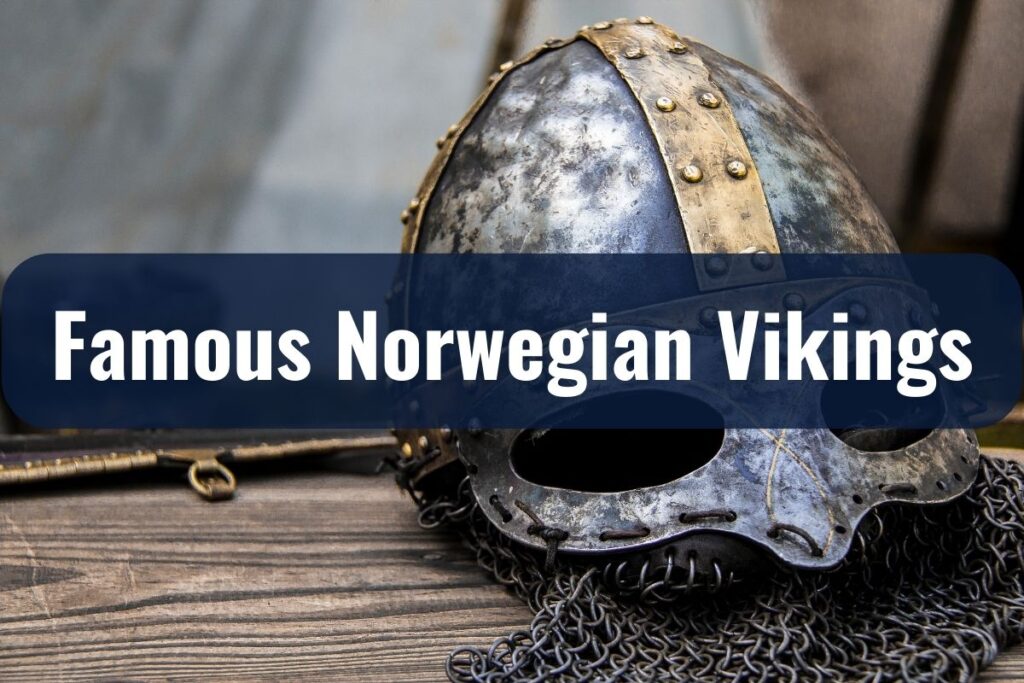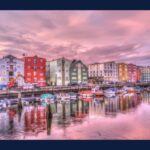Vikings! The very name conjures up images of fearsome warriors, intricate longships, and myths that have stood the test of time. But what if I told you that there’s so much more to this legendary community than what’s typically portrayed on screen?
Today, let’s navigate through the fjords of history to explore the Norwegian Vikings, the fascinating people who not only raided but also traded, explored, and crafted stories that still echo through the annals of time.
Key Takeaways
- Norwegian Vikings were not just raiders but also skilled traders, explorers, and artists.
- Seafaring was vital to Viking culture, influencing trade, exploration, and military endeavors.
- Vikings had a rich tapestry of art, craftsmanship, and mythology that influenced their society.
- Notable Norwegian Vikings like Harald Fairhair, Erik the Red, and Leif Erikson made significant contributions to history.
- The Viking legacy continues to impact modern language, exploration, and even pop culture.
Origins of the Vikings in Norway
The Early Viking Age
The canvas of Viking history is both vast and vivid, but let’s anchor our ship in the fjords where it all began—Norway. The Viking Age, commonly dated from the late 8th to the early 11th century, was a transformative period not just for Norway, but for much of Europe. However, what was it like in Norway before the Viking longships began their voyages of exploration and conquest?
Imagine a land of scattered communities, bound together by kinship and the rugged landscapes they called home. During this early medieval period, Norway was divided into small kingdoms and chiefdoms, each fiercely independent but interconnected through trade and marriage alliances. In a land where the winters were harsh and the arable land limited, the Norwegians turned to the sea for sustenance and, eventually, a way of life that would make them famous.
Societal Structure and Life in Early Medieval Norway
The society was stratified, yet flexible. At the top were the chieftains and kings, distinguished not just by birth but also by their skills in leadership, warfare, and diplomacy. Next were the free farmers and craftsmen who played an essential role in both the local economy and the communal legal system. Slavery existed but was more akin to serfdom than the chattel slavery known from other periods and places.
Despite the stratification, one remarkable aspect of early Viking society was the relatively high status of women. They could own property, request a divorce, and even become powerful figures in their communities. All of these societal roles were governed by an oral legal tradition, later codified as medieval law codes, which focused on communal responsibility and the resolution of disputes through a democratic assembly known as the “Thing.”
The Role of Seafaring

Importance of the Sea to Norwegian Vikings
If you thought Vikings were just about horned helmets and battle cries, brace yourself. In Norway, the sea wasn’t just a body of water; it was a highway to distant lands, a provider of food and resources, and, let’s not forget, a stage for some of the most compelling stories ever told.
The geography of Norway, with its labyrinth of fjords, rugged coastline, and proximity to open sea routes, made the Norwegian Vikings inherently connected to maritime life. Farming was an option, but when the landscape offers you a fleet of natural harbors and an open invitation to the Atlantic, you’d be remiss not to accept it.
Norwegian Vikings looked to the sea for sustenance—fishing was a mainstay—but they also saw its greater potential. For them, the sea was a canvas on which they could paint their destiny, a wide-open stage for the drama of exploration, trade, and sometimes even conflict to unfold.
Innovations in Shipbuilding
What’s a seafaring nation without its ships? Much like the artists of their time, who etched intricate designs into stone and metal, Viking shipbuilders were masters of their craft. They created longships, which were not only fast and agile but also capable of both sailing the high seas and navigating shallow rivers. These weren’t just boats; they were state-of-the-art marine technology, crafted meticulously with oaken planks, held together by iron rivets, and powered by both oars and sails.
But what really set these ships apart was their dual functionality. You see, these longships were not merely modes of transportation; they were also formidable tools of warfare. With a dragon’s head often carved into the bow and shields hanging along the sides, a Viking longship was an awe-inspiring sight that signaled both prestige and power.
Exploration and Expansion
Routes Taken by Norwegian Vikings
With sails billowing in the North Atlantic wind and stars twinkling like a celestial map, the Norwegian Vikings ventured beyond the known world. If you’ve ever felt the thrill of standing at the edge of a cliff, staring at the horizon and wondering what lies beyond, then you can perhaps imagine the excitement these seafarers felt as they navigated uncharted waters.
From their homeland’s rugged coastlines, the Norwegian Vikings set forth in various directions. Some voyaged westward, crossing the North Atlantic to reach the Faroe Islands, Iceland, Greenland, and even North America, long before Columbus made his historic journey. Others sailed south, down to the British Isles and the European continent, and still others ventured east through rivers and lakes, penetrating deep into Russia and reaching as far as the Byzantine Empire.
Settlements in Iceland, Greenland, and North America
But these voyages were not mere pleasure cruises. The Vikings were settlers, explorers, and traders. Take Iceland, for example. The island became a sort of “Viking frontier,” settled in the late 9th century primarily by Norwegian chieftains and their families. Iceland was not just a stepping stone but became a vibrant Norse culture center, giving birth to sagas that would be told for generations.
Then there’s the tale of Erik the Red, who was exiled from Iceland for manslaughter. Far from being deterred, Erik set his sights on even more remote lands and discovered Greenland. He smartly named it “Greenland” as a marketing ploy to attract settlers, despite the island’s largely icy terrain. His gambit worked, and a colony was established.
And let’s not forget one of the most mind-boggling expeditions: the journey to North America. Leif Erikson, Erik the Red’s son, is credited with being one of the first known Europeans to set foot on the continent, around the year 1000 AD. Sites like L’Anse aux Meadows in Newfoundland bear archaeological evidence of Norse settlement, adding credence to the sagas that spoke of a land called “Vinland.”
So you see, the voyages of the Norwegian Vikings were not just random seafaring adventures; they were purposeful journeys that expanded the boundaries of the known world. Through their travels, they changed the course of history, affecting cultures and economies far removed from their Scandinavian homeland.
Viking Raids

Famous Raids and Their Impacts
The Viking raid—a scene so vividly etched in popular imagination that it’s almost impossible not to picture horned helmets, fierce battle cries, and blazing fires. But hold on to your axes; the truth is far more nuanced. Viking raids were indeed brutal at times, but they were also a complex blend of strategy, economics, and cultural interaction.
One of the earliest and most iconic raids was the attack on the monastery at Lindisfarne, off the northeast coast of England, in 793 AD. This event sent shockwaves throughout Europe and is often cited as the beginning of the Viking Age. Following this, Norwegian Vikings primarily targeted coastal regions and islands of the British Isles, including monasteries that were rich in treasures but poor in defenses.
The raid on Paris in 845 AD, led by the legendary Viking chieftain Ragnar Lothbrok—assuming he wasn’t just a figure of legend—stands as another example of a large-scale operation that demonstrated both Viking audacity and tactical brilliance. Despite facing a well-fortified city, the Vikings utilized their mastery of rivers and seas to stage a successful siege, eventually extracting a hefty ransom from the besieged Parisians.
Viking Raids as Cultural Exchange
But let’s shift our gaze from the gleam of stolen treasure to something equally shiny but far more enduring—the exchange of cultures. When Norwegian Vikings raided or settled in new lands, they didn’t just take; they also gave, albeit inadvertently. Their interactions led to a mixing of languages, religions, and even political systems.
Take Ireland, for example. The Vikings began raiding Irish monasteries in the 8th century but eventually settled and established port cities like Dublin. What started as a hostile incursion led to trade, intermarriage, and a blend of Norse and Irish cultures.
Moreover, the Vikings didn’t just bring back looted gold and silver; they also brought back slaves, crafts, and foreign goods, including spices and fabrics. These items were integrated into Norwegian society, enriching it and making it part of a larger, interconnected European world.
So, when we talk about Viking raids, it’s essential to look beyond the caricature of ruthless plunderers. These were strategic missions conducted by people who, whether they intended to or not, ended up playing a significant role in the cultural and economic shaping of medieval Europe.
Art and Craftsmanship
Unique Designs in Weapons, Jewelry, and Textiles
Step into the vibrant tapestry of Viking life, and you’ll find that it wasn’t all about sailing, raiding, and trading. Beneath the hardened exterior of these seafaring warriors lay a rich tradition of art and craftsmanship. Far from being mere plunderers, the Norwegian Vikings were also creators, fashioning objects that were not only functional but also deeply symbolic.
Ever seen a Viking sword? It wasn’t just a piece of metal; it was a work of art, often adorned with intricate patterns, inlays, and even runic inscriptions. These swords were passed down as heirlooms, carrying the legacy of their owners. And let’s not forget the equally captivating jewelry—bronze and silver arm rings, necklaces, and brooches often featured delicate filigree work, animal motifs, and even mythological tales.
It wasn’t just metalwork that captivated the Viking artisans; they were skilled in textile arts as well. The vibrant hues of their clothes, often made from wool or linen, were achieved through a complex process of dyeing using natural ingredients like plants and lichens. These textiles often bore geometric designs, a testament to the Viking’s mathematical skills.
Runestones and Their Significance
Now, let’s turn the pages—or rather, the stones—to the intriguing world of Viking runestones. These weren’t just chunks of rock; they were a Viking version of social media! Carved with runic alphabets and often colored with vivid pigments, these stones were used to commemorate the dead, tell tales of heroism, or even record significant events.
What’s fascinating is that these runestones were often erected along well-traveled routes, serving as public notices for those who could interpret the runes. They give us rare insights into the Viking’s world, their beliefs, and their aspirations. Some runestones found in Norway and other parts of the Viking world even depict scenes from Norse mythology, serving as tangible links to the spiritual realm they revered.
The art and craftsmanship of the Norwegian Vikings offer a window into their daily life and belief systems. They show us that these were people with an appreciation for beauty, complexity, and storytelling, as much in peace as in war.
Religion and Mythology

The Pantheon of Norse Gods and Goddesses
The enigmatic realm of Norse gods and legends! If you ever wondered what inspired the Viking raiders to set forth on perilous journeys or what comforted them during the dark winters, look no further than their fascinating belief system. Let’s lift the misty veil and step into Asgard, the realm of gods, where Odin, Thor, and a host of other deities reside.
Odin, the Allfather, was not just a god of war and death; he was also the god of wisdom, poetry, and magic. His thirst for knowledge was so immense that he sacrificed an eye for a drink from the Well of Wisdom. Thor, the thunder god, was another crowd favorite, his hammer Mjölnir a symbol of protection and power, much like the amulets worn by Viking warriors.
But it wasn’t just male gods who held sway in the Viking cosmos. Goddesses like Freyja, associated with love, fertility, and beauty, also played crucial roles. Freyja was so revered that she got to choose half of the fallen warriors in battles, with the other half going to Odin.
The Concept of Fate and the End Times
In a world where death could come swiftly, whether in battle, at sea, or through natural causes, the notion of fate or “wyrd” was central to Viking belief. Life’s events were woven by the Norns, mysterious beings who decided the fate of gods and humans alike. Unlike many other belief systems, where one could defy destiny, in Norse mythology, even the gods were bound by the fate spun for them.
And oh, what a fate it was! Ever heard of Ragnarök? It’s the Norse version of the end of the world—a cosmic battle involving gods, giants, and monstrous creatures. Even though it foretold the death of many gods, including Odin and Thor, it was also a story of renewal, where a new world would rise from the ashes of the old.
Integration into Daily Life
Religion wasn’t just a separate sphere; it was intricately woven into the fabric of daily life. Rituals, feasts, and sacrifices, often held at sacred groves or stone formations, were communal events that strengthened social bonds. Runes were not just alphabetic symbols; they were believed to have magical properties, often used for divination or to invoke protection.
So, from the battle cries on the longships to the quiet prayers before a communal feast, the spiritual world of Norse mythology offered both explanation and inspiration. It was a belief system that embraced the complexities of human existence, from the joys of love and community to the uncertainties of fate and the finality of death.
Norwegian Vikings and Trade
The Vital Role of Trade in Viking Society
Batten down the hatches, for we’re setting sail on another captivating voyage—this time into the bustling ports and vibrant markets of the Viking world! Often overshadowed by their exploits of raiding and seafaring, the role of trade in Norwegian Viking society is a facet that’s not just fascinating but crucial to understanding their way of life.
Remember, not every Viking was a sword-wielding raider; many were skilled traders who sailed along established trade routes to exchange goods like furs, iron, and amber for silver, spices, and fine textiles. The seaports of Norway, such as Bergen, became thriving hubs of commerce, gateways to a vast network that extended from the Arctic Circle to the Mediterranean.
Merchandise and Trading Partners
The sights and sounds of a Viking marketplace—a cacophony of languages, a kaleidoscope of colors, and an array of exotic scents! Think about it: a Norse trader could barter Norwegian fish for Arabian spices, Baltic amber for Frankish wine, and Russian furs for English wool. This blend of products and cultures made these marketplaces melting pots of civilization.
The Vikings traded not only with nearby lands like the British Isles and Western Europe but also with far-flung places like Byzantium and the Islamic Caliphates. Artifacts such as Arabic silver coins and Byzantine silks found in Norwegian soil stand as testimonies to this extensive network of trade.
Ships: The Backbone of Viking Trade
We’ve talked about Viking longships in the context of raids and explorations, but let’s not forget their indispensable role in trade. Designed to navigate both open sea and shallow rivers, these versatile vessels were ideal for carrying a wide range of goods. Certain ships, known as “knarrs,” were even specialized for trading, designed to carry heavy cargo.
The Social and Economic Impact
The economic benefits of trade trickled down to various aspects of Viking society, allowing for specialization in crafts, accumulation of wealth, and even the sponsorship of art and storytelling. The stories of faraway lands brought back by traders added fuel to the ever-burning Viking curiosity and thirst for adventure.
It’s worth noting that trade also facilitated the flow of ideas and technologies. From new methods of shipbuilding to foreign styles of art and decoration, the influx of outside influence kept the Viking world dynamic and ever-evolving.
Famous Norwegian Vikings

Larger-Than-Life Legends and Real Historical Figures
Prepare to embark on a journey through time and myth, as we delve into the tales of some of the most famous Norwegian Vikings! These characters, some shrouded in the mists of legend and others rooted in historical records, were the rockstars of their age—warriors, explorers, and kings who left an indelible mark on history and folklore alike.
| Viking Name | Notable Achievements |
| Harald Fairhair | Unified Norway under a single rule, initiating territorial expansion. |
| Erik the Red | Discovered and settled Greenland after being exiled from Norway and Iceland. |
| Leif Erikson | Reached North America around 500 years before Christopher Columbus. |
| Olaf Tryggvason | Escaped slavery to become a Norwegian king and promoted Christianity in Norway. |
| Gudrid Thorbjarnardóttir | Explored from Norway to Greenland, then North America, and made a pilgrimage to Rome. |
Harald Fairhair
Let’s kick off our star-studded list with none other than Harald Fairhair, the man often credited with unifying Norway under a single rule for the first time. Legend has it that Harald vowed never to cut or comb his hair until he became the king of all Norway—a promise he kept, earning him his memorable moniker.
With his charismatic leadership and tactical brilliance, Harald reigned over a period of territorial expansion, paving the way for Norway’s future as a unified kingdom.
Erik the Red
Next up, meet Erik Thorvaldsson, better known as Erik the Red. If ever there was a Viking who could turn adversity into opportunity, it was him.
Exiled from Norway and later from Iceland, Erik set his sights on uncharted territories, eventually discovering and settling Greenland. It was Erik’s knack for branding that led him to name this icy land “Greenland,” perhaps one of history’s most successful real estate marketing campaigns!
Leif Erikson
While we’re talking about Greenland, it’s hard to ignore Leif Erikson—son of Erik the Red. Leif didn’t just inherit his father’s adventurous spirit; he took it a step further by sailing to North America nearly 500 years before Christopher Columbus. The settlements he established, though short-lived, earned him a place in history as one of the first European explorers to reach the New World.
Olaf Tryggvason
Now, let’s switch gears to Olaf Tryggvason, a Norwegian king with a flair for drama. Captured by Estonian pirates as a child and sold into slavery, Olaf’s story reads like an epic saga of revenge and redemption. He eventually regained his freedom, returned to Norway, and became a fervent promoter of Christianity, albeit through somewhat forceful methods.
Gudrid Thorbjarnardóttir
Before we wrap up, it’s crucial to remember that Viking society had its share of formidable women as well. Gudrid Thorbjarnardóttir was one such woman, an intrepid explorer who traveled from Norway to Greenland, then to North America, and finally made a pilgrimage to Rome! Her journeys were so legendary that she became the subject of sagas and songs, a Viking heroine for the ages.
Legacy of Norwegian Vikings
The Dawn of a New Era: The End of the Viking Age
As all good things must come to an end, so did the Viking Age. The conversion to Christianity, the rise of centralized kingdoms, and changes in military technology all played their part in closing this remarkable chapter in history. But fear not, for the end of the Viking Age did not mean the end of the Viking legacy; rather, it marked the beginning of something new, something that would become an integral part of the European tapestry.
Influence on Language and Literature
Did you know that a number of English words—like ‘husband,’ ‘egg,’ and even ‘window’—have Old Norse roots? That’s right! The Viking presence in the British Isles had a profound impact on the English language. Their sagas, composed in the Old Norse language, are some of the most enduring works of literature from the medieval world, offering glimpses into the Viking mindset, their social norms, and their incredible voyages.
Contributions to Exploration and Mapping
The Norwegian Vikings were pioneers in many ways, and their contributions to exploration and cartography are immeasurable. Their voyages to Iceland, Greenland, and North America expanded the known world. Maps from the Viking Age, while not accurate by modern standards, were revolutionary in their time and served as valuable guides for subsequent generations of explorers.
Fusion of Cultures and Faiths
The Vikings were not just takers; they were also receivers, absorbing elements from the diverse cultures they came into contact with. This amalgamation is particularly evident in the art and architecture from the later Viking period, which often features a fusion of Norse and Christian motifs. Likewise, the blend of pagan and Christian beliefs produced a rich tapestry of myths and legends, some of which still endure in modern Scandinavian folklore.
Political Influence and Statecraft
From Harald Fairhair’s unification efforts to the more organized system of laws and governance, the Norwegian Vikings laid the foundations for the emergence of a strong, centralized state. Their legacy can be seen in the formation of the medieval Scandinavian kingdoms and, indirectly, in the shaping of modern-day Norway.
In the Fabric of Modern Imagination
Finally, the Norwegian Vikings continue to capture our imagination—whether in the pages of history books, the reels of Hollywood films, or even the digital landscapes of video games. They symbolize an indomitable spirit of adventure, a thirst for discovery, and a complex, multifaceted culture that defies simple categorization.
The Vikings may have put away their swords and furled their sails, but their legacy lives on, not just in Norway but across the world. From language and literature to exploration, statecraft, and beyond, the echoes of their footsteps can still be heard, urging us on to new horizons and adventures.
Related: New to Norway: Embracing Life in Norway
Additional Resources
- “The Sea of Trolls” by Nancy Farmer: A spellbinding novel that blends historical settings with Norse mythology, perfect for young adults and adults alike.
- “The Vikings: A History” by Robert Ferguson: An accessible and comprehensive look at Viking history, culture, and impact.
- “Norse Mythology” by Neil Gaiman: A gripping retelling of the Norse myths that captivated the Vikings themselves.
- “Vikings”: A historical drama series that offers a stylized but captivating look into the lives of legendary Vikings like Ragnar Lothbrok.
- “The Vikings Who Shocked the Victorians”: A documentary that explores how the Viking image has been romanticized and misconstrued over time.
- “The Lost Treasures of the Vikings”: Journey into the world of Viking artifacts and the stories they tell.
- The Viking Ship Museum in Oslo: Home to well-preserved Viking ships and artifacts.
- Lofotr Viking Museum: A museum in the Lofoten Islands where you can experience Viking history in a unique setting.
- National Museum in Copenhagen: Though not in Norway, this museum has an extensive collection of Viking artifacts.
- The Árni Magnússon Institute for Icelandic Studies: A treasure trove of medieval manuscripts.
- Viking Network: An online resource that offers scholarly articles, maps, and educational material on Viking history.
- “Norse by Northwest”: A podcast that delves deep into Norse mythology and Viking history.
- “The History of Vikings”: Interviews with scholars and authors to provide a nuanced understanding of Viking culture.


